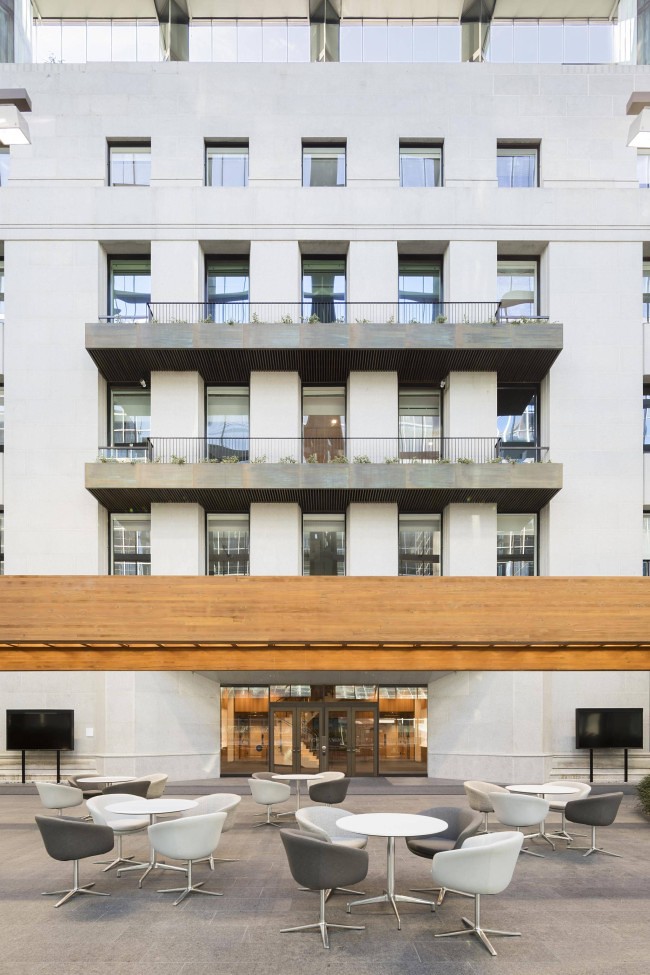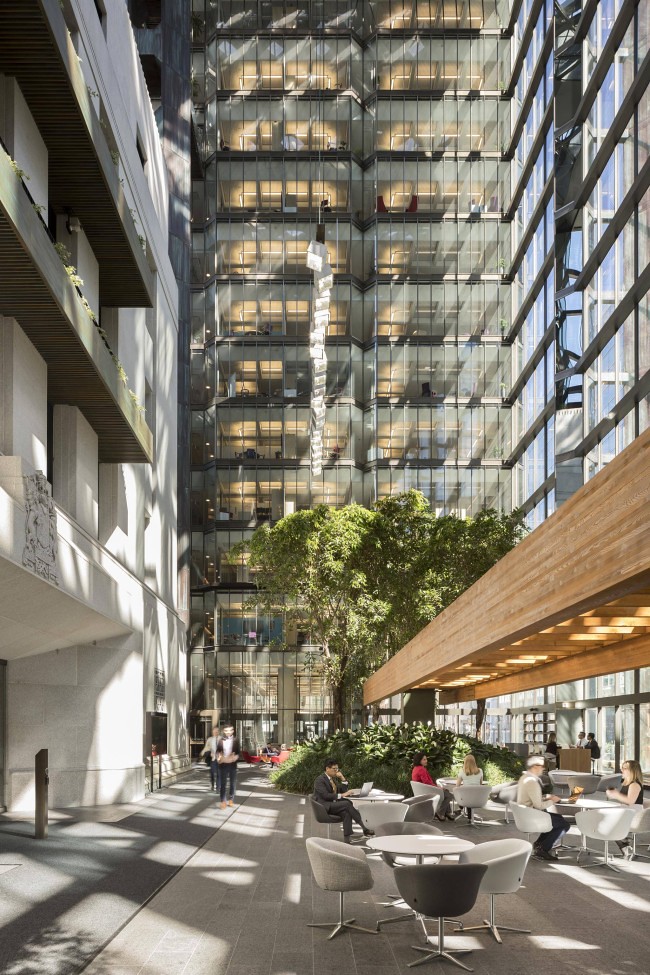When architecture meets collective values
The Bank of Canada’s three-year, $460-million renovation has made its offices more collegial, but also more fortress-like
Alex Bozikovic
OTTAWA
The Globe and Mail
Last updated: Thursday, Apr. 13, 2017 3:45PM EDT

On a winter day, Ottawa looked as if it had all the colour sucked out of it. As I visited the headquarters of the Bank of Canada recently, the building’s reflective glass mirrored shades of greige in the cityscape’s slush, asphalt and limestone.
Then I stepped inside the bank’s atrium, a 12-storey-tall space lined with shimmering glass, steel and nubbly green copper and populated by mounds of plantings and tall fig trees. It looked and felt as though it was a different world. Bank staffers lounged in the tropical comfort, reading on hot-orange chairs or sitting with laptops at oak bar tops.
Yet I only got to see this (after lengthy negotiations) as a journalist. This space, designed by eminent architect Arthur Erickson with Marani Rounthwaite & Dick in the 1970s, was once open to the public. No longer: The bank’s three-year, $460-million renovation, being completed this spring, has made its offices safer, more collegial and more commodious. And more fortress-like.
All the magic of the atrium is now locked away from the street. Within, the very competent and corporate renovation, led by the Toronto office of Perkins + Will, has taken one of the most interesting public buildings in the country’s capital and turned it into an impenetrable box.

A lot of work needed to be done to the 836,000-square-foot complex, which consisted of a 1938 building on Wellington Street flanked by Erickson’s 12-storey 1979 towers. The project earthquake-proofed the building, replaced its 40-year-old mechanical systems, improved accessibility and energy efficiency, created new conference space and relocated the bank’s museum.
According to the bank’s COO, Filipe Dinis, it has also made the bank function better. “The building did not serve the way we work today,” he said. “It was not serving to bring people together. Now we have created new spaces for collaboration.”
The office floors, originally wide open, have been completely remade to strip away 30 years of “piecemeal” additions and renovations; most floors are now largely filled with low cubicles, with the concrete waffle slabs exposed and new lighting and climate-control systems slipped into them. Raised floors accommodate data, electrical and radiant heating. All this does not match the quirkiness of the bank’s 1970s offices, when custom office furniture was arranged around the building’s “tree” columns. But it works, breaking down the physical evidence of the bank’s internal hierarchies. Breakout spaces by each floor’s elevator encourage people to mix with their colleagues. It looks like the seventies, and yet this is the contemporary wisdom of tech companies. Space makes people collaborate. The views, to Parliament Hill and to the atrium, are largely shared.
“Our job was to change the culture,” said Andrew Frontini, design director at Perkins + Will’s Toronto office. “We were trying to integrate a 21st-century workplace into the existing towers and keep Erickson’s architecture – bring it back to its base and make it really evident and readable.”
But the project’s approach to Erickson’s building was deeply controversial. When it launched in 2013, there was an uproar from preservation advocates. Phyllis Lambert of the Canadian Centre for Architecture wrote that the plans would “desecrate” the building: “The proposed changes are like adding something to a work by Michael Snow, Picasso, or Michelangelo,” she wrote. In particular, the atrium as a public space was “the soul of the building” and should be preserved. But, as a Crown corporation, the bank was free to alter its architectural legacy.
Its architecture was already a conversation between eras: the conservative Canada of the 1930s and the ambitious, globally minded state of the 1970s. The 1938 building is a taut granite box in the style now called “stripped classical.” It begins with the neo-classicism that banks have long used to express their conservatism and solidity; the front façade has rectangular columns, but they are very shallow, almost two-dimensional. Glance and it’s a temple; look more closely and it is a tentatively modern building. The stone urns on either side symbolize the storage of wealth. It was designed by former Royal Bank architect Sumner Davenport with Toronto’s Marani, Lawson & Morris, a firm (later Marani Rounthwaite & Dick) whose work “could be described as conservative,” one of their peers wrote, “based on sound traditional principles.”
That was decidedly not the case for Erickson. Arguably Canada’s greatest architect of the 20th century, he gave local currency to a series of modernist ideas: brutalism, the “megastructure” of Simon Fraser University, and in the 1980s postmodernism’s playful use of historic ornament. The 1970s bank building belongs to his late modernist period, when he also designed Toronto’s Roy Thomson Hall. Like other architects, he was flirting with reflective glass and inscrutable sculptural forms.

His building wraps around the 1938 building with two towers and an atrium – an enclosed space that turns the older building into a sculptural object in a garden.
Erickson loved landscape and did much with his buildings to link architecture and the natural world, as he did with the Law Courts at Vancouver’s Robson Square, designed with Cornelia Hahn Oberlander. At the Bank of Canada, working with Ronald Dick, he intended for the garden to bridge Sparks Street and continue into the lobby of the new government building next door; in the end, the more restrained version was inside the bank alone, a multilevel landscape with three mounds of earth surrounded by a “lake.” A Douglas fir trellis links two of the mounds, a metaphorical bridge across the landscape. This is the zone, about 12,000 square feet and filled with tropical plants, that was long open to the public.
Bank governor Louis Rasminsky “likes to run a closed shop when it counts,” The Globe and Mail reported in 1971, “but feels it is the bank’s duty to share the upstairs area with the public who made it possible.”
So what happened? The bank decided, it says on the advice of security consultants, to close it off. “It’s in terms of what we’ve seen on the international front – the unfortunate situations we’ve seen from a security perspective,” Dinis said. “There is a perimeter that usually is established around a central bank.”
What he is reluctant to say explicitly is that the bank fears a bomb. When members of the public can enter the atrium, they’re right below windows of the older building, where senior executives have their offices.
Is such a threat plausible? Is it likely? And if so, why not simply make people in the atrium pass through a security checkpoint? That would head off the more likely lone-gunman assaults, such as Michael Zehaf-Bibeau’s 2014 attack on Parliament Hill or the March 22 attack on Westminster in London, while keeping the space publicly accessible.
Well, look around: The atrium is now being used by the bank. New centres at each end of the building serve employee-orientation and learning purposes. In between, the atrium is a very beautiful space for ideation and collaboration. “The idea is, irrespective of where you are in the building, that is part of your workspace,” Dinis said. “And that includes these spaces.”
Outside, the space at the eastern end of the building has been dramatically altered. Erickson designed a flat plaza paved with slate and raised by three steps – echoing the foundation of Greek temples. The Perkins + Will team “viewed it as an unfinished, non-committal landscape response,” Frontini said. “Erickson had many ambitions – and I think at one point it was just left to be executed. I don’t think it had the same impact as the building.” Therefore, “it was fair game for a 21st-century design element that integrates landscape and architecture.”

The renovation creates a ramp, making the area accessible to all, then peels up the plaza surface to form three pyramids. One of these provides the entrance to the museum, now relocated outside the security perimeter. All the pyramids have windows that illuminate the underground museum space, and all three are topped with seating and plantings. The museum, as yet incomplete, will be accessible and generously supplied with back-of-house space; it connects to conference rooms carved out of the bank’s basements.
Frontini cites an Erickson project as a precedent for the pyramids: the architect’s Canadian pavilion at Expo 70 in Osaka. But those structures were covered in mirror glass, like the Bank of Canada towers. Their “ambiguity of form and changeability of image,” Erickson wrote, “suggest ongoingness and infinity.”
The new pyramids look awfully finite. They are clad mostly in black granite. Their forms don’t echo the 1970s so much as the 2000s: The notion of peeling up the ground to form a building has appeared several times in the work of New York’s Diller Scofidio + Renfro and is something of a contemporary cliché. A friend of mine calls this gambit “the Pringle.”
Is it wrong to put Pringles on a plinth? The existing public space was not so remarkable or distinctive that it demanded total preservation. But these new additions are expressions of their own period. In the thirties, government built a temple you could visit. In the seventies, a green atrium open to all. Today it constructs fortifications and builds Pringles to push public space underground.
Architecture always expresses our collective values – never more so than here. Back in 1971, Erickson told The Globe: “The Bank of Canada is a working part of society, not a fortress where you need a pass to get in.” As I walked away from the bank down Sparks Street, I looked through the windows at the lush space within. In the translucent glass, my reflection looked thin and grey.
http://www.theglobeandmail.com/arts/...ticle34703077/



